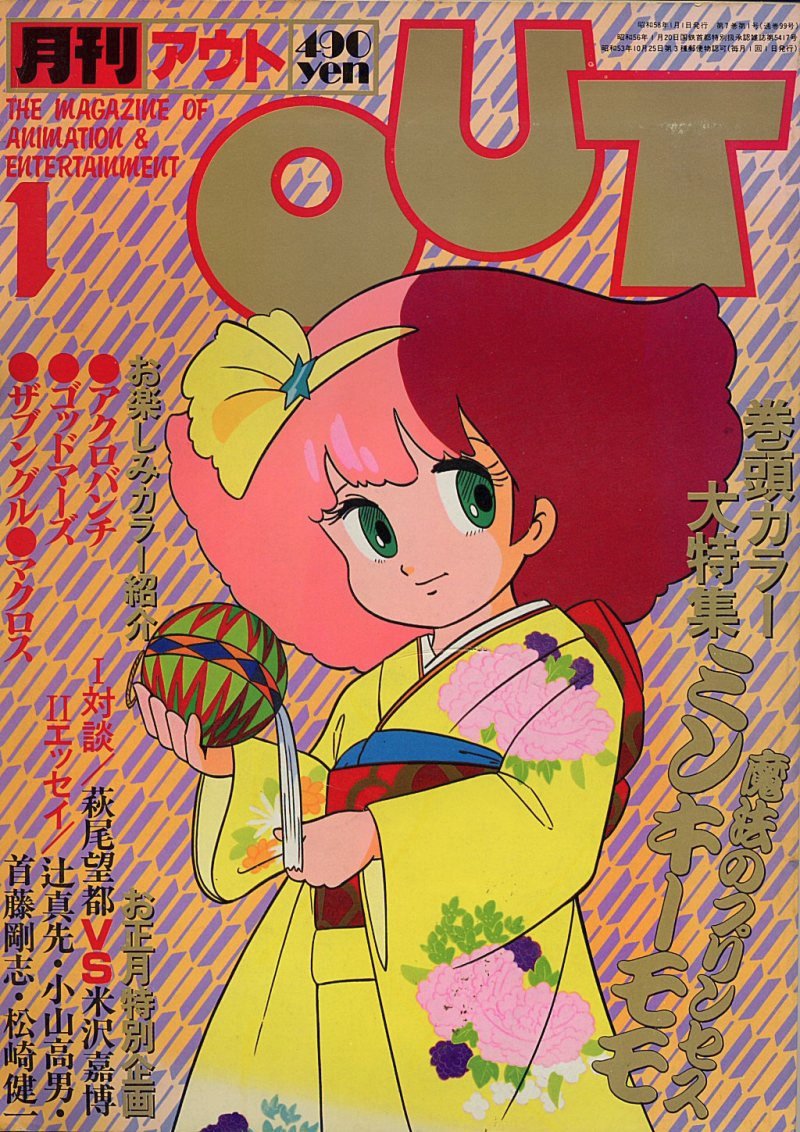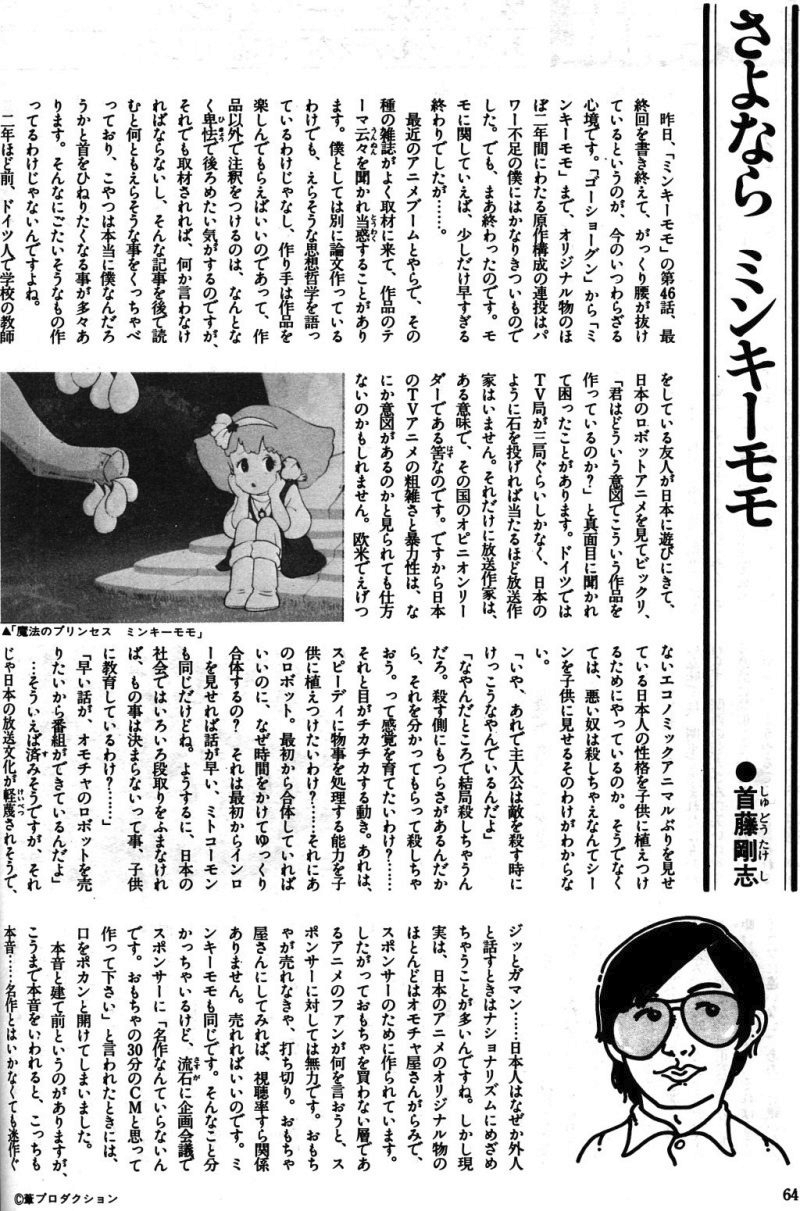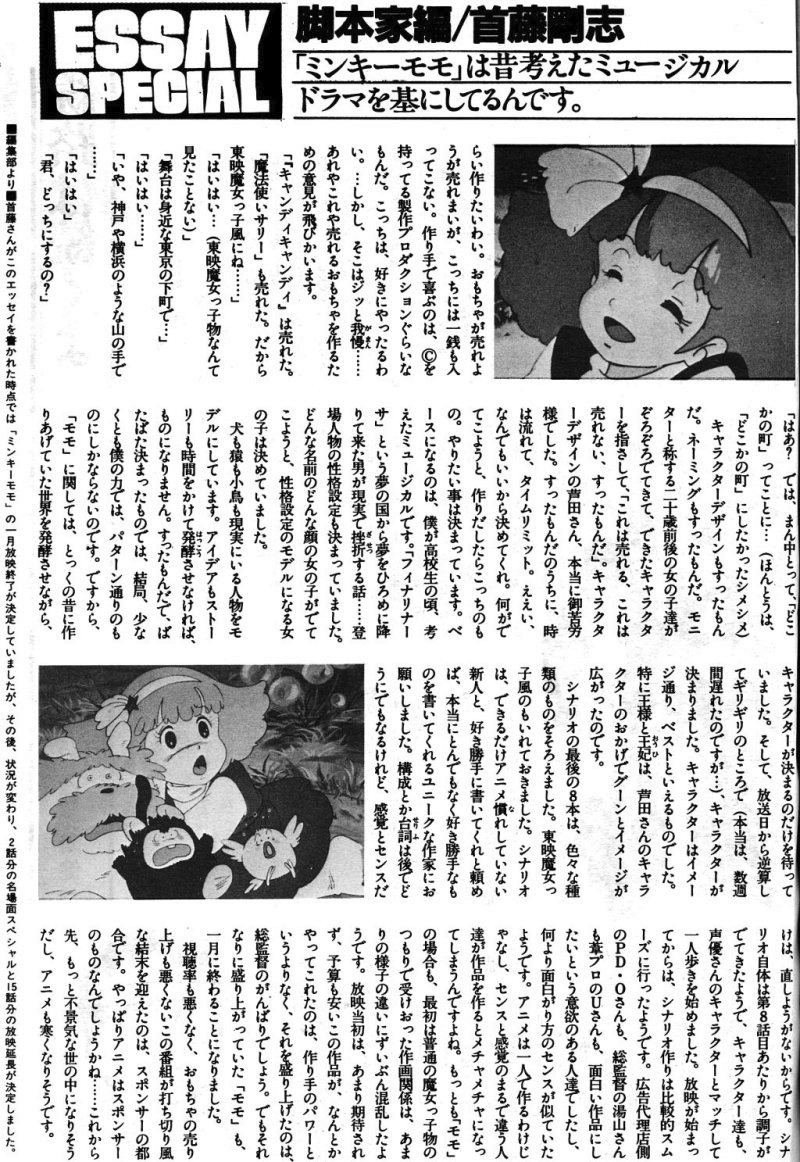This is the essay written by Takeshi Shudô, writer of the « Magical Princess Minky Momo » series, about the death of the main character Momo in the first series. It was published in the japanese magazine « OUT » released in January, 1983.
The English translation has been done using automatic translation that I fixed up a bit, but don’t rely on it for accuracy.
This is the source essay referenced by this article on Anime News Network, however it doesn’t exactly tells the same story. Shudô seems to be bitter about the series coming to an abrupt end but he doesn’t explicitly says that the death of Momo comes from the sponsor’s decision to cancel the series. The original story he wrote as a teenager seemed to already end badly.
The full text can be found here.
Thanks to @parotaku for pointing me out the article and @tsukinure2 [website] for correcting the OCR mistakes.

ESSAY SPECIAL
「ミンキーモモ」は昔考えたミュージカルドラマを基にしてるんです。
さよならミンキーモモ
しゅどうたけし●首藤剛志
昨日、「ミンキーモモ」の第46話、最終回を書き終えて、がっくり腰が抜けているというのが、今のいつわらざる心境です。「ゴーショーグン」から「ミンキーモモ」まで、オリジナル物のほぼ二年間にわたる原作構成の連投はパワー不足の僕にはかなりきついものでした。でも、まあ終わったのです。モモに関していえば、少しだけ早すぎる終わりでしたが……。
最近のアニメブームとやらで、その種の雑誌がよく取材に来て、作品のテーマ云々を聞かれ当惑することがあります。僕としては別に論文作っているわけでも、えらそうな思想哲学を語っているわけじゃなし、作り手は作品を楽しんでもらえばいいのであって、作品以外で注釈をつけるのは、なんとなく卑怯で後ろめたい気がするのですが、それでも取材されれば、何か言わなければならないし、そんな記事を後で読むと何ともえらそうな事をくっちゃべっており、こやつは本当に僕なんだろうかと首をひねりたくなる事が多々あります。そんなにごたいそうなもの作ってるわけじゃないんですよね。
二年ほど前、ドイツ人で学校の教師をしている友人が日本に遊びに来て、日本のロボットアニメを見てビックリ、「君はどういう意図でこういう作品を作っているのか?」と真面目に聞かれ困ったことがあります。ドイツではTV局が三局ぐらいしかなく、日本のように石を投げれば当たるほど放送作家はいません。それだけに放送作家は、ある意味で、その国のオピニオンリーダーである筈なのです。ですから日本のTVアニメの粗雑さと暴力性は、なにか意図があるのかと見られても仕方ないのかもしれません。欧米でえげつないエコノミックアニマルぶりを見せている日本人の性格を子供に植えつけるためにやっているのか。そうでなくては、悪い奴は殺しちゃえなんてシーンを子供に見せるそのわけがわからない。
「いや、あれで主人公は敵を殺す時にけっこうなやんでいるんだよ」
「なやんだところで結局殺しちゃうんだろ。殺す側にもつらさがあるんだから、それを分かってもらって殺しちゃおう。って感覚を育てたいわけ?……それと目がチカチカする動き。あれは、スピーディに物事を処理する能力を子供に植えつけたいわけ?それにあのロボット。最初から合体していればいいのに、なぜ時間をかけてゆっくり合体するの?それは最初からインローを見せれば話が早い、ミトコーモンも同じだけどね。ようするに、日本の社会ではいろいろ段取りをふまなければ、もの事は決まらないって事、子供に教育しているわけ?…….」
「早い話が、オモチャのロボットを売りたいから番組ができているんだよ」
…そういえば済みそうですが、それじゃ日本の放送文化が軽蔑されそうで、ジッとガマン……日本人はなぜか外人と話すときはナショナリズムにめざめちゃうことが多いんですね。しかし現実は、日本のアニメのオリジナル物のほとんどはオモチャ屋さんがらみで、スポンサーのために作られています。したがっておもちゃを買わない層であるアニメのファンが何を言おうと、スポンサーに対しては無力です。おもちゃが売れなきゃ、打ち切り。おもちゃ屋さんにしてみれば、視聴率すら関係ありません。売れればいいのです。ミンキーモモも同じです。そんなこと分かっちゃいるけど、流石に企画会議でスポンサーに「名作なんていらないんです。おもちゃの30分のCMと思って作って下さい」と言われたときには、口をポカンと開けてしまいました。
本音と建前というのがありますが、こうまで本音をいわれると、こっちも本音…名作とはいかなくても迷作ぐらい作りたいわい。おもちゃが売れようが売れまいが、こっちには一銭も入ってこない。作り手で喜ぶのは、©を持ってる製作プロダクションぐらいなもんだ。こっちは、好きにやったるわい。…しかし、そこはジッと我慢……あれやこれや売れるおもちゃを作るための意見が飛びかいます。
「キャンディキャンディ」は売れた。「魔法使いサリー」も売れた。だから東映魔女っ子風にね……」
「はいはい・・・(東映魔女っ子物なんて見たことない)」
「舞台は身近な東京の下町で…」
「はいはい…….」「いや、神戸や横浜のような山の手で…….」
「はいはい」
「君、どっちにするの?」
「はあ? では、まん中とって、「どこかの町」ってことに…(ほんとうは、「どこかの町」にしたかったシメシメ)キャラクターデザインもすったもんだ。ネーミングもすったもんだ。モニターと称する二十歳前後の女の子達がぞろぞろでてきて、できたキャラクターを指さして、「これは売れる、これは売れない、すったもんだ」。キャラクターデザインの芦田さん、本当に御苦労様でした。すったもんだのうちに、時は流れて、タイムリミット。ええい、なんでもいいから決めてくれ。何がでてこようと、作りだしたらこっちのもの。やりたい事は決まっています。ベースになるのは、僕が高校生の頃、考えたミュージカルです。「フィナリナーサ」という夢の国から夢をひろめに降りて来た男が現実で挫折する話…登場人物の性格設定も決まっていました。どんな名前のどんな顔の女の子がでてこようと、性格設定のモデルになる女の子は決めていました。
犬も猫も小鳥も現実にいる人物をモデルにしています。アイデアもストーリーも時間をかけて発酵させなければ、ものになりません。すったもんだ、ばたばた決まったものでは、結局、少なくとも僕の力では、パターン通りのものにしかならないのです。ですから、「モモ」に関しては、とっくの昔に作りあげていた世界を発酵させながら、キャラクターが決まるのだけを待っていました。そして、放送日から逆算してギリギリのところで(本当は、数週間遅れたのですが…)、キャラクターが決まりました。キャラクターはイメージ通り、ベストといえるものでした。特に王様と王妃は、芦田さんのキャラクターのおかげでグーンとイメージが広がったのです。
シナリオの最初の8本は、色々な種類のものをそろえました。東映魔女っ子風のもいれておきました。シナリオは、できるだけアニメ慣れしていない新人と、好き勝手に書いてくれと頼めば、本当にとんでもなく好き勝手なものを書いてくれるユニークな作家にお願いしました。構成とか台詞は後でどうにでもなるけれど、感覚とセンスだけは、直しようがないからです。シナリオ自体は第8話目あたりから調子がでてきたようで、キャラクター達も、声優さんのキャラクターとマッチして一人歩きを始めました。放映が始まってからは、シナリオ作りは比較的スムーズに行ったようです。広告代理店側のPD・Oさんも、総監督の湯山さんも葦プロのUさんも、面白い作品にしたいという意欲のある人達でしたし、何より面白がり方のセンスが似ていたようです。アニメは一人で作るわけじゃなし、センス感覚のまるで違う人達が作品を作るとメチャメチャになってしまうんですよね。もっとも「モモ」の場合も、最初は普通の魔女っ子物のつもりで受けおった作画関係は、あまりの様子の違いにずいぶん混乱したようです。放映当初は、あまり期待されず、予算も安いこの作品が、なんとかやってこれたのは、作り手のパワーというよりなく、それを盛り上げたのは、総監督のがんばりでしょう。でもそれなりに盛り上がっていた「モモ」も、一月に終わることになりました。
視聴率も悪くなく、おもちゃの売り上げも悪くないこの番組が打ち切り風な結末を迎えたのは、スポンサーの都合です。やっぱりアニメはスポンサーのものなんでしょうかね……これから先、もっと不景気な世の中になりそうだし、アニメも寒くなりそうです。
■編集部より■首藤さんがこのエッセイを書かれた時点では「ミンキーモモ」の一月放映終了が決定していましたが、その後、状況が変わり、2話分の名場面スペシャルと15話分の放映延長が決定しました。
PD・Oさんとは読売広告社の大野実プロデューサー、葦プロのUさんとは梅原勝プロデューサーのことです(いずれも当時) [source]
シナリオの最後の8本は、 →OCR的には間違ってないが、「シナリオの最初の8本は、」が内容的には正しい。


“Minky Momo » is based on a musical drama I came up with a long time ago.
Goodbye Minky Momo
by Takeshi Shudo
Yesterday, I finished writing the 46th and final episode of « Minky Momo » and I am feeling down and out of sorts, which is how I am feeling at the moment. I have been working for almost two years on a series of original compositions from « GoShogun » to « Minky Momo », which was quite hard for me because of my lack of power. But, well, it’s done. As far as Momo is concerned, it ended a little too soon…
With the recent anime boom, magazines of that type often come to interview me and ask me about the theme of my work, which sometimes confuses me. As for me, I am not writing an article or talking about my philosophical philosophy, I just want people to enjoy my works, and I feel somewhat cowardly and guilty about making comments about something other than my works.. When I read it later, I often wonder if it is really me. It’s not that I’m making something so grandiose.
Two years ago, a German friend of mine who is a school teacher came to Japan for a visit and was surprised to see Japanese robot animation. I was once troubled when he asked me earnestly, « What is your intention in creating such works? In Germany, there are only about three TV stations, and there are not as many broadcasters as there are in Japan. Therefore, broadcasters are, in a sense, supposed to be opinion leaders in their countries. Therefore, the crudeness and violence of Japanese TV animation may be seen as a sign that there is an agenda. Are they trying to instill in children the character of the Japanese people, who in the West are showing a grotesque economic animal behavior? Otherwise, I don’t understand the reason for showing children scenes in which bad guys should be killed.
“No, the main character is in a lot of pain when he kills the enemy.”
“I know you end up killing them even if you’re worried about it. The person who kills has pain, too, so let’s make them understand it and kill them. …… And the flickering movement of the eyes. Is that to instill in the child the ability to process things quickly? And that robot. Why take the time to slowly merge when they should have merged right from the start? It would be easier to show the in-laws from the beginning, the same with Mitkomon. In short, do you educate your children that in Japanese society, things are not decided unless various arrangements are made?”
“In short, the program is made to sell toy robots.”
…I could go on and on, but that would be disrespectful to Japanese broadcasting culture, so I’ll just hold my breath… For some reason, Japanese people are often awakened to nationalism when they talk to foreigners. However, the reality is that most of the original Japanese anime is associated with toy stores and made for sponsors. Therefore, no matter what anime fans, a segment of the population that does not buy toys, say, they are powerless against the sponsors. If the toy maker does not sell, it is cancelled. For the toy stores, it doesn’t even matter what the ratings are. As long as it sells, that’s all that matters. The same goes for Minky Momo. I know that, but at the planning meeting, the sponsor said
« We don’t need a masterpiece, just a 30-minute commercial for a toy, » and my mouth dropped open.
There is a saying that there are two sides to every story, but when someone says something like this, it makes me think of it this way… Even if it is not a masterpiece, I would like to make a long-range work. Whether the toys sell well or not, we don’t get a penny. The only people who will be happy are the production companies that have the ©. We will do as we want. However, we had to be patient and… have a flurry of opinions on how to make toys that sell.
““Candy Candy » sold well. “Sally the Wizard” sold well. So make it like Toei Magical Girl.”
I’ve never seen a Toei Magical Girl series.
“It takes place in a familiar downtown Tokyo neighborhood…”
“Okay.”
“…No, in an uptown area like Kobe or Yokohama”
“Okay.”
“Which way do you want it?”
“Huh? Then, let’s take the middle and call it « Some town » »… (actually, we wanted to call it « Some Town »…). We had a lot of trouble with the character design. The character design was also a struggle, as was the naming. Girls around 20 years old came out in droves to monitor the project, pointed at the characters, and said, « This one will sell, this one won’t, » and had a tough time. Mr. Ashida, the character designer, really did a great job. Time was running out and the time was up. We were all very happy with the result, but we had to make a decision. No matter what comes out of it, once we start making it, it’s ours. I have already decided what I want to do. The base of the project is a musical I came up with when I was in high school. It is a story about a man who comes down from a dreamland called “Fenarinarsa” to spread his dream only to fail in reality. Whatever the name of the girl, whatever her face, I had decided that this would be the model for the girl.
The dog, cat, and bird are all modeled after real people. Ideas and stories have to ferment over time to become something. If they are decided in a blur, they will only end up following a pattern, at least with my help. Therefore, for « Momo, » I was working on the world I had created long ago, waiting only for the character to be decided. Then, at the very last minute, counting backward from the broadcast date (actually, it was a few weeks late…), the character was decided. The characters were exactly as we had imagined and could be called the best. The king and queen, in particular, were the ones whose image was enhanced thanks to Mr. Ashida’s characters.
For the first eight scenarios, we had a variety of different types. I also included a Toei Magical Girl style. For the scenarios, I asked newcomers who were not used to animation as much as possible, and unique writers who, if I asked them to write whatever they wanted, would write something really outrageous and arbitrary. The structure and dialogue can be changed later, but there is no way to fix the sense of feeling and taste. The scenario itself seemed to get better from around the 8th episode, and the characters began to walk on their own, matching the characters of the voice actors. Once the show started airing, the scenario development seemed to go relatively smoothly. Mr. PD-O from the advertising agency, Mr. Yuyama, the general director, and Mr. U from Ashi Production were all highly motivated to make the work interesting, and above all, they seemed to have a similar sense of how to make it interesting. Animation is not a one-person production, and when people with different senses of taste create a work, it can become a mess. In the case of « Momo » as well, those who initially accepted it with the intention of making an ordinary magical girl story were quite confused by the difference in the way it was created.
The fact that this work, which was not expected to be very popular and had a low budget when it first aired, was able to make it through is not only due to the power of the creators, but also to the efforts of the general director who made it more exciting. However, « Momo, » which had been a reasonably exciting production, came to an end in January.
The reason why this show, which did not have bad ratings and toy sales, came to a cancelled-like end is for the convenience of its sponsors. I guess animation is for sponsors after all… The world is going to be more recessionary in the future, and anime is going to get colder.
■ From the Editor ■ At the time Mr. Shudô wrote this essay, « Minky Momo » was scheduled to end its airing in January, but the situation has since changed and the show has been extended for two episodes of a special of famous scenes and 15 episodes.
Notes:
PD-O refers to Minoru Ohno, a producer at Yomiko Advertising, and Mr.U refers to Masaru Umehara, a producer at Ashi Production (both at the time). [source]
The original text refers to “the last 8 scenarios” but this is most probably a typing mistake, since Shudô seems to be talking about the 8 first scenarios.